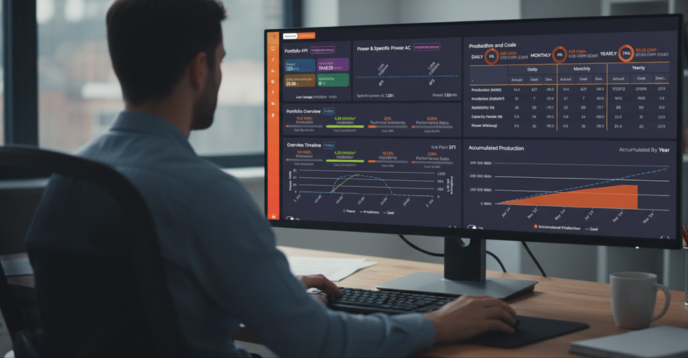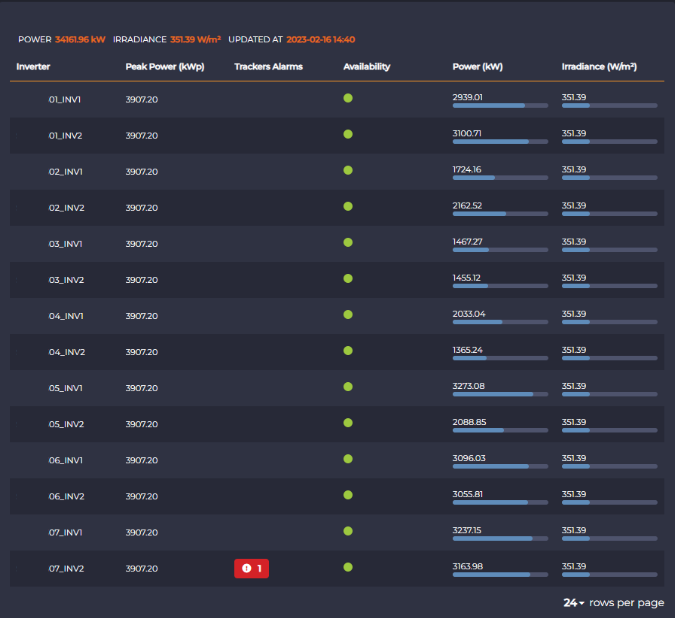Precision in Performance: How Delfos Empowers Solar Leaders with Operational KPIs That Drive Results

In utility-scale solar, the difference between an efficient plant and a lagging one often lies in what you can see and act on. Portfolio Managers and Heads of Asset Management don’t just need visibility; they need reliable, granular KPIs that translate technical status into operational action and financial impact.
At Delfos, our Solar Asset Performance module was designed to deliver exactly that. Backed by more than 15 GW of monitored assets and 100+ predictive and operational algorithms, we equip energy leaders with smart, actionable KPIs that close the gap between monitoring and optimization.
Why KPIs Matter More Than Ever in Solar Asset Management
For CEOs and Asset Managers overseeing multi-site portfolios, these are some of the most pressing challenges:
- Inconsistent or incomplete monitoring from inverter portals
- Lack of standardization in reporting across plants
- High response times to underperformance or failures
- Inability to correlate alarms with actual performance impact
- Limited visibility into component-level inefficiencies like string boxes, trackers, or transformers
Without the right KPIs, decisions get delayed, O&M efforts become untimely, and energy losses go unclaimed and uncorrected.
Delfos: Operational KPIs That Power Smart Decisions
Delfos provides a comprehensive set of Solar Performance KPIs across all operational layers of the plant—from high-level energy generation to deep equipment-level diagnostics.
Energy KPIs
- Energy generation
- Energy availability
- Contractual availability
- DC-AC efficiency
These indicators form the foundation of any performance report, enabling CEOs and Portfolio Managers to evaluate whether each plant is achieving its commercial targets.
Irradiation KPIs
- Transposition factor – Quantifies the transposition gain and detects pyranometer miscalibrations.
- Irradiation comparative – Evaluates site irradiance for resource assessment and performance monitoring.
These KPIs ensure resource evaluation: critical for audit trails, performance optimization, and accurate predictions of energy yield.
Balance of Plant (BoP) and Equipment Losses
- BoP losses – Quantify non-inverter sources of inefficiency.
- String/String Box lost energy – Isolate and track underperformance beyond the inverter.
- Trackers availability, deviation & misalignment alarms – Diagnose tracking issues that impact daily yield.
- String/Combiner Box availability – Supports loss allocation and inspection targeting.
This level of granularity is what sets Delfos apart: we don't just show that a plant is underperforming: we show where and why.

Environmental and Thermal KPIs
- Ambient temperature
- Inverter/Module temperature deviation
- Internal temperature alarms (inverter, transformers, modules, IGBT)
Temperature-based KPIs help identify hidden causes of degradation, allowing Maintenance Managers to intervene early, avoid failures, and extend equipment life.

Beyond Monitoring: What Makes Delfos Different?
While other platforms stop at data visualization, Delfos integrates these KPIs into an intelligent platform that supports:
- Real-time monitoring (via Smart Monitoring module)
- Energy Loss Breakdown (via Waterfall analysis module)
- Predictive analytics (Failure Prediction and APM modules)
- Automated reporting and alerting (customizable by persona or need)
This means your KPIs don’t live in a dashboard: they feed your strategy, workflows, and financial planning.
The Strategic Value for Each Role
- Asset Managers: Gain equipment-level clarity to prioritize resources and fine-tune performance contracts.
- Portfolio Managers: Compare site performance, standardize KPIs, and unlock scalable insights across geographies.
- Maintenance Managers: Receive smart alerts and thermal deviations that pinpoint issues before they escalate.
- Heads of Asset Management: Gain full-chain visibility and operational control over technical availability and revenue assurance.
- CEOs: Make investment, O&M, and growth decisions with confidence backed by auditable, real-time data.
KPIs Are Not Just Indicators, They’re Catalysts
Delfos’ KPI framework turns solar operations into a measurable, improvable, and scalable engine of value. Whether you're troubleshooting a failing tracker or reporting availability to investors, these insights drive the outcomes that matter most.
Book a meeting
Let's connect and forge new partnerships
Custom Renewable Energy Solutions
Contact us today and join global operators who recovered up to 10% revenue and cut downtime by 18%


.png)